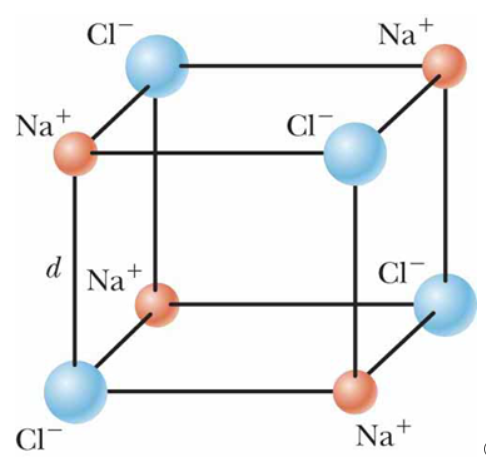Your roommate is having trouble understanding why solids form. He asks, "Why would atoms bond into solids rather than just floating freely with respect to each other?" To help him understand at least one type of bonding in solids, you decide to embark on an energy explanation. You show him a drawing of a primitive cell of a sodium chloride crystal, NaCl, or simple table salt. The drawing is shown in the figure below, where the orange spheres are Na+ ions and the blue spheres are Cl− ions. Each ion has a charge of magnitude equal to the elementary charge e. The ions lie on the corners of a cube of side d. You explain to your roommate that the electrical potential energy is defined as zero when all eight charges are infinitely far apart from each other. Then you bring them together to form the crystal structure shown. a) Evaluate the electric potential energy of the crystal as shown.
Your roommate is having trouble understanding why solids form. He asks, "Why would atoms bond into solids rather than just floating freely with respect to each other?" To help him understand at least one type of bonding in solids, you decide to embark on an energy explanation. You show him a drawing of a primitive cell of a sodium chloride crystal, NaCl, or simple table salt. The drawing is shown in the figure below, where the orange spheres are Na+ ions and the blue spheres are Cl− ions.
Each ion has a charge of magnitude equal to the elementary charge e. The ions lie on the corners of a cube of side d. You explain to your roommate that the electrical potential energy is defined as zero when all eight charges are infinitely far apart from each other. Then you bring them together to form the crystal structure shown.
a) Evaluate the electric potential energy of the crystal as shown.

Trending now
This is a popular solution!
Step by step
Solved in 2 steps with 1 images









